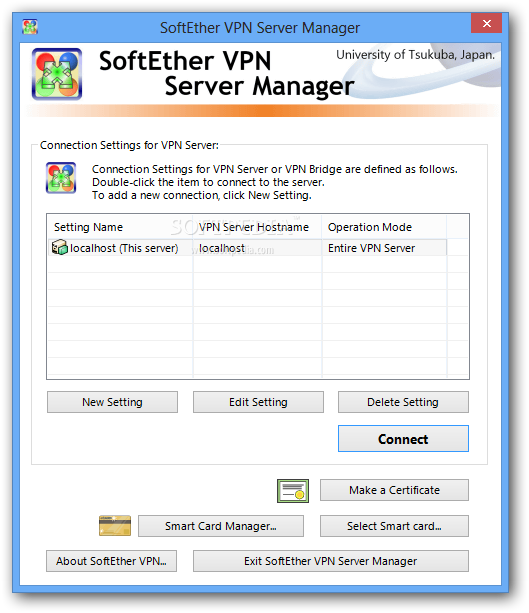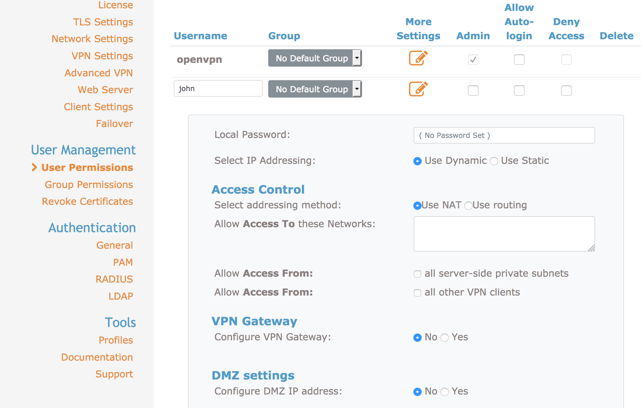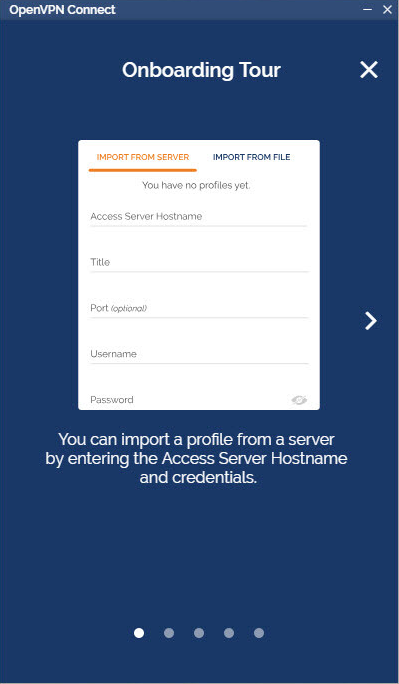Connecting with an OpenVPN 2.5 client to at least one commercial VPN service that implemented their own cipher negotiation method that always reports back that it is using BF-CBC to the client is broken in v2.5. This has always caused warning about mismatch ciphers. We have been in contact with some service providers and they are looking into it. On the security front, ‘best in class’ 256-bit encryption is in place, along with support for OpenVPN, L2TP/IPsec, and PPTP protocols, and a private, encrypted DNS. ExpressVPN doesn’t log. Download Latest Stable Release. Tunnelblick helps you control OpenVPN ® VPNs on macOS. It is Free Software that puts its users first. There are no ads, no affiliate marketers, no tracking — we don't even keep logs of your IP address or other information.
In this page you find:
In this page appears the list of the Endian UTM Appliance’s connections asOpenVPN clients, i.e., all tunnelled connections to remote OpenVPNservers. For every connection, the list reports the status, the name,any additional option, a remark, and the actions available:
- the server is active or stopped.
- modify the server’s configuration
- remove the configuration and the server.
The status is closed when the connection is disabled, establishedwhen the connection is enabled, and connecting… while theconnection is being established. Beside to enable and to disable aconnection, the available actions are to edit or delete it. In theformer case, a form will open, that is the same as the one that openswhen adding a connection (see below) in which to see and modify thecurrent settings, whereas in the latter case only deletion of thatprofile from the Endian UTM Appliance is permitted.
The creation of a new OpenVPN client connections is straightforwardand can be done in two ways: Either click on the Add tunnelconfiguration button and enter the necessary information about theOpenVPN server to which to connect (there can be more than one) orimport the client settings from the OpenVPN Access Server by clickingon Import profile from OpenVPN Access Server.
There are two types of settings that can be configured for each tunnelconfiguration: The basic one includes mandatory options for the tunnelto be established, while the advanced one is optional and normallyshould be changed only if the OpenVPN server has a non-standardsetup. To access the advanced settings, click on the >>button next to the Advanced tunnel configuration label. The basicsettings are:
A label to identify the connection.
The remote OpenVPN server’s FQDN, port, and protocol in theform myvpn.example.com:port:protocol. The port andprotocol are optional and left on their default values whichare 1194 and udp respectively when not specified. Theprotocol must be specified in lowercase letters.
The server certificate needed for the tunnel connection.Browsing the local filesystem is admitted, to search for thefile, of the path and filename can be entered. If the serveris configured to use PSK authentication (password/username),the server’s host certificate (i.e., the one downloaded fromthe Download CA certificate link in the server’sMenubar ‣ VPN ‣ OpenVPN server section)must be uploaded to the Endian UTM Appliance. Otherwise, to usecertificate-based authentication, the server’s PKCS#12 file(i.e., the one downloaded from the Export CA asPKCS#12 file link on the server’s Menubar ‣VPN ‣ OpenVPN server ‣ Advanced section) must beuploaded.

Insert here the Challenge password, if one was supplied tothe CA before or during thecreation of the certificate. This is only needed whenuploading a PKCS#12 certificate.
If the server is configured to use PSK authentication(password/username) or certificate plus passwordauthentication, provide here the username and password of theaccount on the OpenVPN server.
A comment on the connection.
In this box, that appears when clicking on the >> buttonin the previous box, additional options can be modified, though thevalues in this box should be modified only if the server side has notbeen configured with standard values.
One or more (one per line) fallback OpenVPN servers in thesame format used for the primary server, i.e.,myvpn.example.com:port:protocol. The port and protocolvalues default to 1194 and udp respectively when omitted. Ifthe connection to the main server fails, one of these fallbackservers will take over.
Hint
The protocol must be written in lowercase letters.
The device used by the server, which is either TAP or TUN.
This drop-down menu is not available if TUN has been selectedas Device type, because in this case the connection type isalways routed. Available options are routed (i.e., theclient acts as a gateway to the remote LAN) or bridged(i.e., the client firewall appears as part of the remoteLAN). Default is routed.
This field is only available if TAP has been selected asDevice type and the connection type is bridged. Fromthis drop-down menu, select the zone to which this clientconnection should be bridged.
This option is only available if the Connection type isrouted. Tick this checkbox to hide the clients connectedthrough this Endian UTM Appliance behind the firewall’s VPN IPaddress. This configuration will prevent incoming connectionsrequests to the clients. In other words, incoming connectionswill not see the clients in the local network.
Tick this checkbox to avoid receiving DHCP responses from theLAN at the other side of the VPN tunnel that conflict witha local DHCP server. Hikvision plugin for firefox mac.
Compress the traffic passing through the tunnel, enabled bydefault.
The protocol used by the server: UDP (default) or TCP. Set toTCP only if an HTTP proxy should be used: In this case, a formwill show up to configure it.
If the Endian UTM Appliance can access the Internet only through an upstreamHTTP proxy, it can still be used as an OpenVPN client in aGateway-to-Gateway setup, but the TCP protocol for OpenVPN must beselected on both sides. Moreover, the account information for theHTTP upstream proxy must be provided in the text fields:
The HTTP proxy host, e.g., proxy.example.com:port, withthe port defaulting to 8080 if not entered.
The proxy account information: The username and thepassword.

A forged user agent string can be used in some casesto disguise the Endian UTM Appliance as a regular web browser,i.e., to contact the proxy as a browser. This operation mayprove useful if the proxy accepts connections only for sometype of browsers.
Once the connection has been configured, a new box at the bottom ofthe page will appear, called TLS authentication, from which toupload a TLS key file to be used for the connection. These options areavailable:
The key file to upload, searchable on the local workstation.

Openvpn Client For Linux
The MD5 checksum of the uploaded file, which will appear assoon as the file has been stored on the Endian UTM Appliance.
This value is set to 0 on servers and to 1 on clients.
The second possibility to add an account is to directly import theprofile from an OpenVPN Access Server: In this case, the followinginformation must be provided:
A custom name for the connection.
Open Vpn Clients
The URL of the OpenVPN Access Server.
Note
Note that the Endian UTM Appliance only supportsXML-RPC configuration of the OpenVPN Access Server,therefore a URL input here has the form:https://<SERVERNAME>/RPC2.
Openvpn Client Windows
The username and password on the Access Server.

If this checkbox is ticked and the server is running on an SSLencrypted connection, then the SSL certificate will be checkedfor validity. Should the certificate not be valid then theconnection will be immediately closed. This feature might bedisabled when using a self-signed certificate.

A comment to recall the purpose of the connection.